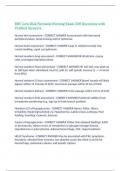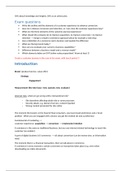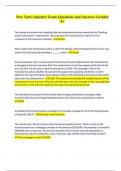RNC Low Risk Neonatal Nursing Exam 328 Questions with Verified Answers
Normal skin assessment - CORRECT ANSWER Acrocyanosis with decreased peripheral pulses, facial bruising and/or petechiae
Normal head assessment - CORRECT ANSWER Large in relation to body size, cranial molding, caput succedaneum
Normal newborn lung assessment - CORRECT ANSWER RR 40-60/min, coarse rales, prolonged expiration phase
Normal newborn heart assessment - CORRECT ANSWER HR 120-160, may peak up
to 180 bpm when stimulated, loud S2, split S2, soft systolic murmur (L —> R shunt
from PDA)
Normal newborn GI tract assessment - CORRECT ANSWER Bowel sounds will likely
appear within 15 minutes of birth, meconium passage within 24 hrs of birth
Normal newborn kidneys - CORRECT ANSWER Urine passage within 24 hrs of birth
Normal newborn limb assessment - CORRECT ANSWER Positional oddities from intrauterine positioning (e.g., legs up in frank breech position)
Newborn S/S of Hypoglycemia - CORRECT ANSWER Apnea, Pallor, Jittery, Irritability, Weak high-pitched cry, Hypothermia, Labile temps, Lethargy, Poor feeding, Vomiting, Cyanosis, Seizures
Causes of Hypoglycemia - CORRECT ANSWER (Other than delayed feeding): IUGR or prematurity, Inborn errors of metabolism or glycogen storage disease, Hypothermia or polycythemia, Adrenal hemorrhage, CHF, Hyperinsulinism
HELLP Syndrome - CORRECT ANSWER May be associated with PIH; symptoms: hemolysis, elevated liver enzymes, low platelet count; the client is at risk for hemorrhage, pulmonary edema, and hepatic rupture Gestational Hypertension - CORRECT ANSWER Transient elevation of blood pressure occurring for the first time after mid-pregnancy without proteinuria or other signs of preeclampsia (postpartum period: ends by 12 weeks: Gest HTN. beyond 12 weeks: Chronic HTN).
GBS (group B strep) - CORRECT ANSWER Group B streptococcus (GBS) is a type of bacterial infection that can be found in a pregnant woman's vagina or rectum. This bacteria is normally found in the vagina and/or rectum of about 25% of all healthy, adult women. Women who test positive for GBS are said to be colonized
The 30-week-gestation fetus of a primagravid mother has been diagnosed in utero with an omphalocele. Which of the following procedures should the nurse anticipate? - CORRECT ANSWER Karyotyping via amniocentesis; Omphalocele and gastroschisis are both commonly associated with accompanying defects or chromosomal abnormalities. An amniocentesis will likely be performed and karyotyping done to identify any chromosomal abnormalities.
A 38-week-gestation newborn is vigorous at birth. The infant is dried, wrapped in warm blankets and placed on the mother's chest. At 6 minutes of life, the infant still appears cyanotic. According to recommended practice guidelines, which of the following should the nurse perform FIRST? - CORRECT ANSWER Check the infant's pulse oximeter reading
Feedback
Recommended practice guidelines for neonatal resuscitation utilize pulse oximeter readings to determine if an infant is within acceptable saturation range for minutes of life. Use of 100% oxygen is discouraged.
A 39-week-gestation newborn male weighing 3.3 kg (7.3 lbs.) is admitted to the newborn nursery following a cesarean section. How many kilocalories (kcal) should this infant consume to meet the average daily requirement? - CORRECT ANSWER 330 kcal/day
Feedback
Term newborns require approximately 100 kcal/kg/day. Premature infants require approximately 120-150 kcal/kg/day. A nurse is developing a teaching plan for the family of an infant being discharged home with a gastrostomy tube (G-tube). Which of the following steps should be taken FIRST? - CORRECT ANSWER Assess the family's current knowledge base
Feedback
Assessment is the first step in the nursing process. In order to facilitate learning, the learner's knowledge and skills should be assessed before a teaching plan is formed.
A client has arrived at the labor and delivery unit in active labor. The nursing assessment reveals a history of genital herpes with active lesions in the genital tract at present. The nurse plans to: - CORRECT ANSWER Prepare the client for a cesarean delivery
Feedback
A cesarean delivery can reduce the risk of neonatal infection with a mother in labor who has herpetic genital tract lesions. Standard precautions should be maintained.
A 3-day-old, former 35-week-gestation female infant born to a mother with a history of methadone use is beginning to show signs of neonatal abstinence syndrome (NAS). Nursing support measures for this infant should include all of the following EXCEPT: - CORRECT ANSWER Encouraging bottle feeding
Feedback
Breastfeeding is encouraged for bonding, and may also help alleviate some of the infant's symptoms of methadone withdrawal. Bottle feeding should only be encouraged if the infant is not demonstrating adequate weight gain with breastfeeding alone, or if the infant is showing other adverse reactions to breastfeeding. Breastfeeding should not be encouraged when the mother has a history of illicit drug use.
A term infant is diagnosed with intrauterine growth restriction. Which of the following would be a primary factor in determining if this infant's growth restriction is symmetrical or asymmetrical? - CORRECT ANSWER Head circumference
Feedback
Symmetrical growth restriction results in head circumference proportional to infant body size and usually represents fetal etiology that spans all trimesters. Asymmetrical growth restriction is generally head-sparing and infants will have larger head circumference to body size ratios. Asymmetrical growth restriction usually represents maternal etiologies that affect third trimester growth and development.
An obstetric practitioner orders an indirect Coombs test to determine the possibility of maternal-fetal blood interaction. The nurse should: - CORRECT ANSWER Draw the mother's blood
Feedback
An indirect Coombs test performed for obstetric purposes evaluates a mother's blood (usually Rh negative) for free-flowing antibodies against foreign red blood cells (usually those with positive Rh factor). A direct Coombs test is performed on the infant's blood.
A nurse is performing an assessment on a 43-week-gestation male infant. Which physical characteristic should the nurse expect to observe? - CORRECT ANSWER Desquamation
Feedback
The post-term infant (born after the 42nd week of gestation) exhibits dry, peeling,
cracked, almost leather-like skin over the body, which is called desquamation.
A 39-week gestation newborn, weighing 4.8 kg (10.6 lbs.) with Apgar scores of 8 at 1 minute and 9 at 5 minutes following cesarean delivery, is exhibiting tremors of the hands and feet and an increased respiratory rate. This infant is likely demonstrating: - CORRECT ANSWER Symptoms of hypoglycemia
Feedback
Large infants require higher caloric intake to maintain their glycogen stores. Symptoms of hypoglycemia can include limb tremors and tachypnea.
Based on maternal history and current presentation, a 6-day-old term infant is suspected of having herpes simplex meningitis. Which of the following sets of findings is likely to appear in this patient's cerebrospinal fluid (CSF)? - CORRECT ANSWER Elevated RBCs, normal glucose, elevated protein
Feedback
Anticipated CSF findings for acute viral encephalitis include elevated WBCs and RBCs, elevated protein, and normal or decreased glucose levels. Viral cultures are rarely positive and should not be relied upon for diagnosis.






